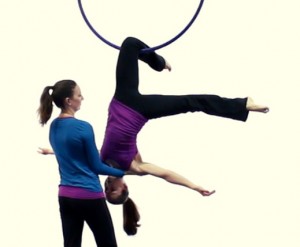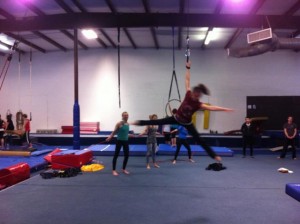The attitude of this blog reveals that experience and mentorship is valued in place of teacher training courses. While teacher training courses are available via the USAG, it is only a supplement, and a small one at that. In some ways it makes sense that in a competitive sport, coaches take on the aire of “been there, done that” and that gives them the credibility to take someone to a competition. It is recommended by the industry and common for a coach to have more than 10 years of experience prior to entering full time coaching. A Pilates instructor writes the following: “You cannot teach something you do not know and you cannot know it unless you commit to ongoing practice.” I find it interesting that with sports such as gymnastics, it is more common to find teachers not engaged in the practice, and that’s when they are called “coaches.” The word coach has a different connotation than teacher and to me, implies that they are done with the sport themselves, and now they are turning a new leaf to coach.
While aerial dance is just as athletic as gymnastics in my opinion, I feel that it is leans in a different direction in the way. Gymnastics seem to wreck your body and then you’re done (while admitting there are always exceptions to the rule!). Circus seems to be more of a lifelong activity. You’ll find plenty of people in their 50s, 60s, and up still engaged in the fun of the circus, where aerial dance has its roots. It’s more of an ongoing lifelong activity, and so instructors are just as much engaged as their students. Rather than coaches who no longer do the sport, aerial instructors are going to be just as much engaged as their students, so it makes sense that the way that they progress into teaching is going to be very different. There’s no such thing as someone taking a 2 week teacher training course and now they are going to coach a gymnastics student to the regional competition. You have to live and breath the industry for years. Simple as that.
ABT (American Ballet Theater) is well-known in the world of Ballet. Did you know you could become certified in ABT Ballet? As long as you meet the necessary skill level, you can get certified in as little as 9 days. This prepares you for teaching children ages 3 and up and you can be as young as 17 years old. A 6 day course prepares teachers to instruct intermediate and advanced ballet students age 11 – 13+. And another 6 day course prepares teachers to instruct advanced and pre-professional ballet students ages 14+. May I emphasis the skill level which allows someone to do this is not beginner, not intermediate, barely advanced. The skill level required to enter the program is advanced and professional.
In the United States, it is very common for dance teachers to receive a masters degree in fine arts from an accredited institution. This degree typically takes about 5 years or more and typically costs anywhere from $40,000-100,000+ depending on what college you attend. Many dance teachers go on to teach at dance studios or in the public or private school system, at levels ranging from elementary school PE to high school dance teams to college dance companies (or being a professor of dance). It is an interesting mix to say the least. Within the same dance studio, you may have someone with no college experience (qualified simply due to natural talent) teaching next to someone with a masters degree. The main thing that the local dance studio cares about is that the teacher can dance and they can teach. Credentials are great, but experience is valued even more within dance studios. In the school system, you absolutely must have your masters degree in order to teach, so that is why so many dancers receive theirs. It keeps doors open for job opportunities.
10,000 HOUR RULE
It is certainly a hard question to answer: What is an adequate length of time to train a teacher? Those who value their art form of teaching may cringe at the suggestion of two weeks. How can someone conquer the art of [fill in the blank with any art form] in 2 weeks if it wasn’t already in them? I remember Debbie Park (my aerial mentor) once telling me that it takes 10 years to become an expert at anything. I have also recently encountered the 10,000 hour rule.
The 10,000 Hour Rule is the idea that it takes approximately 10,000 hours of deliberate practice to master a skill. For instance, it would take 10 years of practicing 3 hours a day to become a master in your subject. It would take approximately 5 years of full-time employment to become proficient in your field. (hmm…sounds like gymnastics coaches perhaps?)
It really is experience more than anything that will make a teacher blossom. I think that a solid teacher training program includes many hours of practice, as well as time for the teacher to grow to a place where they are confident in the skills. It is likely that a teacher may begin teaching while they are still a student of the craft themselves. It is not practical to require every student be practicing their art for 10 years prior to considering teaching. They simply must be a few steps (of course the more the better) ahead of their students, in recognition that it is all one big continuum of learning at the end of the day.
A wonderful yoga practitioner had the following to say on the subject at hand, “I believe people don’t care how much you know until they know how much you care. I care because this practice, this community cares for me. This same care will lead me to the [knowledge I need]. .. I am a student forever, hopefully well beyond 10,000 hours, but today I teach by the minute.”
YOUR TURN
Do you think the aerial dance industry should have teacher training programs that are so common they become necessary part of the industry? What is the ideal length? How long should a teacher be practicing in the aerial arts before they take a teacher training? Lots of room for a million opinions!






